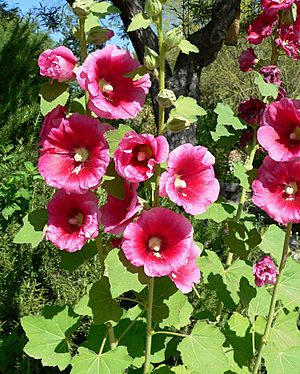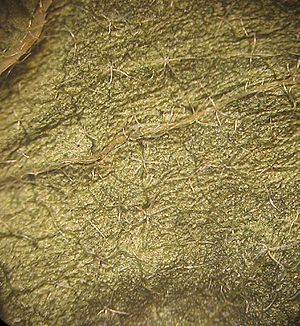Malvaceae facts for kids
Quick facts for kids Malvaceae |
|
|---|---|
 |
|
| Least Mallow, Malva parviflora | |
| Scientific classification | |
| Kingdom: | |
| Division: | |
| Class: | |
| Order: | |
| Family: |
Malvaceae
|
The Malvaceae is a large group of flowering plants. This plant family includes about 1000 different kinds of plants, which are grouped into 75 main categories called genera. You can find these plants in warm, tropical areas and also in cooler, temperate parts of the world. They don't usually grow in very cold places like Antarctica because it's too chilly for them.
Contents
What Malvaceae Plants Look Like
Most plants in the Malvaceae family are small herbs or shrubs. But some can grow into tall trees or even lianas, which are woody vines that climb up other plants.
Leaves and Stems
The leaves of Malvaceae plants usually grow one after another along the stem. Many of them have a shape like an open hand, or they might be divided into smaller leaflets. The edges of the leaves can be smooth, or they can have small teeth. If they have teeth, a tiny vein goes to the tip of each tooth. Small leaf-like parts called stipules are also present where the leaf meets the stem.
The stems of these plants have special tubes and spaces that hold a slimy substance called mucus. Many Malvaceae plants also have tiny hairs on their stems and leaves. These hairs often look like little stars, which is why they are called stellate hairs. Some trees in this family, like those in the Bombacoideae group, have thick, sharp prickles on their stems.
Flowers
Malvaceae flowers often grow in clusters from the leaf axils (where the leaf meets the stem). Sometimes, there's just one flower. These flowers can be either male, female, or have both male and female parts. They are usually symmetrical, meaning you can cut them in half in many ways and get mirror images. They often have noticeable leaf-like structures called bracts around them.
The flowers usually have five sepals, which are like small leaves that protect the bud. These sepals are often joined together at their base. Inside the sepals are five petals, which are the colorful parts of the flower. The flowers have many stamens (the male parts that make pollen), which are often joined together to form a tube around the pistil (the female part). The pistil is made of two or more joined sections called carpels. The ovary (where the seeds develop) is at the top of the flower.
These flowers also have nectaries, which are special glands that make sweet nectar. These nectaries are usually found on the sepals and are made of many tiny, packed hairs.
Fruits
The fruits of Malvaceae plants are most often capsules that split open to release seeds. Some produce fruits that break into smaller parts, and others produce nuts. A well-known fruit from this family is the durian.
Pollination
To make sure they don't pollinate themselves, many Malvaceae plants have a clever trick called protandry. This means the male parts of the flower become ready before the female parts. Most Malvaceae plants are pollinated by insects. Bees, especially certain types of bees from the Apidae family, are known to visit these plants a lot to collect pollen and nectar, helping the plants make new seeds.
Images for kids
-
Swamp rose mallow
-
Common mallow (Malva sylvestris)
-
Close-up photograph of Theobroma cacao flowers.
-
Durian fruits
See also
 In Spanish: Malváceas para niños
In Spanish: Malváceas para niños







